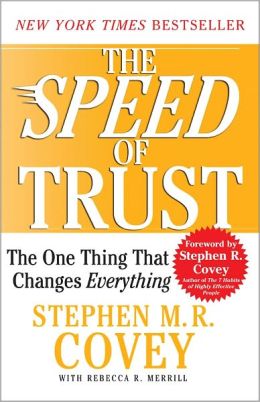The Speed of Trust, by Stephen M.R. Covey, New York: Free Press, 2006. 322 pages.
Reviewed by Diane Byington, Ph.D.
Don’t mistake this Covey with his father, author of the “7 Habits” series. He is his own person, and has written a book that could revolutionize our view of trust in organizations. I highly recommend this book; it is deep and thorough and not to be read in a few evenings. The information and wisdom it possesses should be savored, pondered, and integrated slowly for the greatest impact. When corporate scandals, terrorist threats, and betrayal by our leaders have created low trust on nearly every front, Covey maintains that the ability to establish, grow, extend, and restore trust with all stakeholders is the key leadership competency of the new global economy.
Trust is defined as having confidence. When you trust people, you have confidence in them – in their integrity and their abilities. When you distrust people, you are suspicious of them. Covey cites a study showing that total return to shareholders in high-trust organizations is almost three times higher than the return in low-trust organizations. On a personal level, high-trust individuals are more likely to be promoted, make more money, receive the best opportunities, and have more fulfilling and joyful relationships.
For Covey, trust flows from the inside out, and has five waves: self trust, relationship trust, organizational trust, market trust, and societal trust. Trust begins with us personally, continues into our relationships, expands into our organizations, extends into our marketplace relationships, and encompasses our global society at large. To build trust with others, we start with ourselves.
Self trust is comprised of four cores: integrity, good intent, capability, and results. People with these four aspects are both credible and competent, and they are trustworthy. He devotes a chapter to each of these cores, and each chapter is filled with personal stories as well as practical suggestions for how to increase your trustworthiness. The quickest way to decrease trust is to violate a behavior of character (integrity, good intent) while the quickest way to increase trust is to demonstrate a behavior of competence (capability and results).
Thirteen behaviors in interacting with others grow out of the cores and, if practiced, can increase trust and avoid destroying it. These include: talk straight, demonstrate respect, create transparency, right wrongs, show loyalty, deliver results, get better, confront reality, clarify expectations, practice accountability, listen first, keep commitments, and extend trust. A chapter is devoted to each of these behaviors, along with practical suggestions for increasing trust.
One level builds on another. The main principle of establishing Organizational Trust is alignment – ensuring that all structures and systems within the organization are in harmony with the cores and behaviors. The main principle of Market Trust is reputation, and the main principle of establishing Societal Trust is contribution – demonstrating the intent to give back, to be a responsible global citizen.
There are chapters on how to be smart in your trusting, how to restore trust when it has been lost, and the value of choosing to trust.
If trust is an issue for you personally or for your organization, you will find immediate help in this book. Those who are already involved with high trust organizations and relationships will gain valuable insights that will help you maintain this seemingly “soft” variable that is so vital to profitability and personal fulfillment.
— Diane Byington is a writer and coach who consults with The Booth Company.

